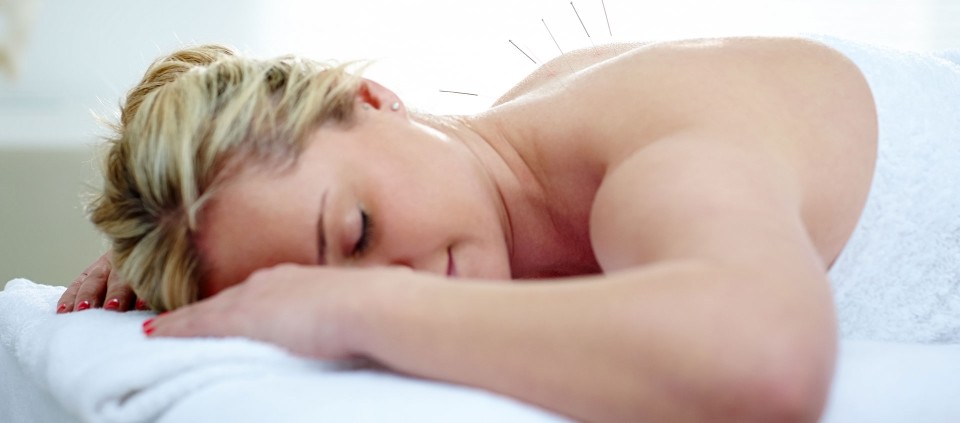An Introduction to Acupuncture

At Kripalu, we are fascinated by the mind-body connection and how it can be harnessed to promote health and well-being. The experience of acupuncture at Kripalu goes deep, supplemented by everything else that you engage in while on retreat: healthy diet, healthy exercise, yoga, mindful outdoor activities, dance, meditation, and deep rest.
As you breathe, relax, and feel the sensations of energy moving during an acupuncture session, aspects of yourself that you might have been unaware of may come to consciousness. By bringing your mind into the present moment as you focus on your breath and sensations, you engage with your body patiently and with kindness.
A Brief History of Acupuncture
Acupuncture practice dates back thousands of years, to Chinese doctors who believed that illness was due to imbalances in energy (qi). Primitive needles were used to stimulate the body’s meridians, or energy-carrying channels, to correct imbalances and restore health. Synonymous with the word qi, ki in Japan and prana in India describe the vital energy that circulates and defines health.
Today, we use finely crafted, one-time-use sterile needles, which make treatment essentially painless and risk free, and yet we still use traditional acupuncture theory, as it remains relevant and vastly practical. The paradigm of energy medicine, at its core nurturing and holistic, is often at odds with Western medicine, in which standardized instruments and precise measurements guide practitioners, the quantity of time spent with patients is often limited and abrupt, and the bottom line of profit-motivated insurance and pharmaceutical companies all too often drives care.
Long, relaxing treatment sessions, and the metaphoric, poetic language inherent in the Asian paradigm of health appeals to many Westerners who are disillusioned with practitioners who don’t view the body as a whole. Hungry for an integrative approach to their health, patients want to be seen and heard. Because a large percentage of illness is chronic, patients often crave reassurance and kindness from their caregivers, and most of all want to be treated with respect.
The Components of Traditional Chinese Medicine
There’s more to Traditional Chinese Medicine than meets the eye. Compared to modern acupuncturists, a practitioner of old was a Jack-of-all-trades or Jill-of-all-trades when it came to the multiple modalities. The big three—acupuncture, herbal medicine, and tai chi—are the most researched aspects of Traditional Chinese Medicine today. Scientific research has produced conflicting conclusions about efficacy for each. The studies least conflicted are those for tai chi, then for acupuncture and then herbal medicine. As a practitioner of all three modalities, I believe the conflicting conclusions might have to do both with the difficulty of designing effective studies and the exponentially increasing detail it takes to safely administer those three modalities. Also, standardized research protocol often misses the forest for the trees.
Adjunctive modalities within Traditional Chinese Medicine are not as widely utilized as acupuncture, herbal medicine, and tai chi. They are therefore not well researched in the West. Yet, many practitioners use the following modalities with confidence in their practice: moxibustion or heat therapy, cupping, electro-acupuncture, tuina, acupressure or gwa sha. In addition, when it comes to tai chi research, protocol has been limited to a most elementary level. I believe advanced static and dynamic qigong and advanced tai chi forms, including weapons forms and Push Hands, are superlative.
Acupuncture for the Diseases of the 21st Century
I’ve primarily worked in destination spa, urban spa, addiction recovery center, and yoga retreat settings throughout my career as an acupuncturist. In these settings, I’ve treated many patients who suffer from anxiety, depression, insomnia, addictions, and fatigue. Time after time, I’ve seen people sink deeply into relaxation in response to acupuncture and feel nourished by the deep peace that envelops them.
Traditional beliefs regarding acupuncture still resonate with people today: for example, the focus on balancing aspects of yourself—yin and yang in Chinese medicine, or the doshas in Ayurveda. We’re also learning more about the physiological mechanisms underlying acupuncture: how and why it works—including its ability to release natural painkillers, block pain, and modulate the hormones that control mood. For many of us, the primary outcome of acupuncture is to help us move out of our habitual fight-or-flight mode, so we can move toward greater balance and health.
Find out about acupuncture sessions at Kripalu.
Greg DiLisio, MAc, is an experienced acupuncturist, Kripalu Legacy Faculty, holds high-level qigong, tai chi, and yoga teacher certifications, and is passionate about moving energy.
Full Bio and Programs